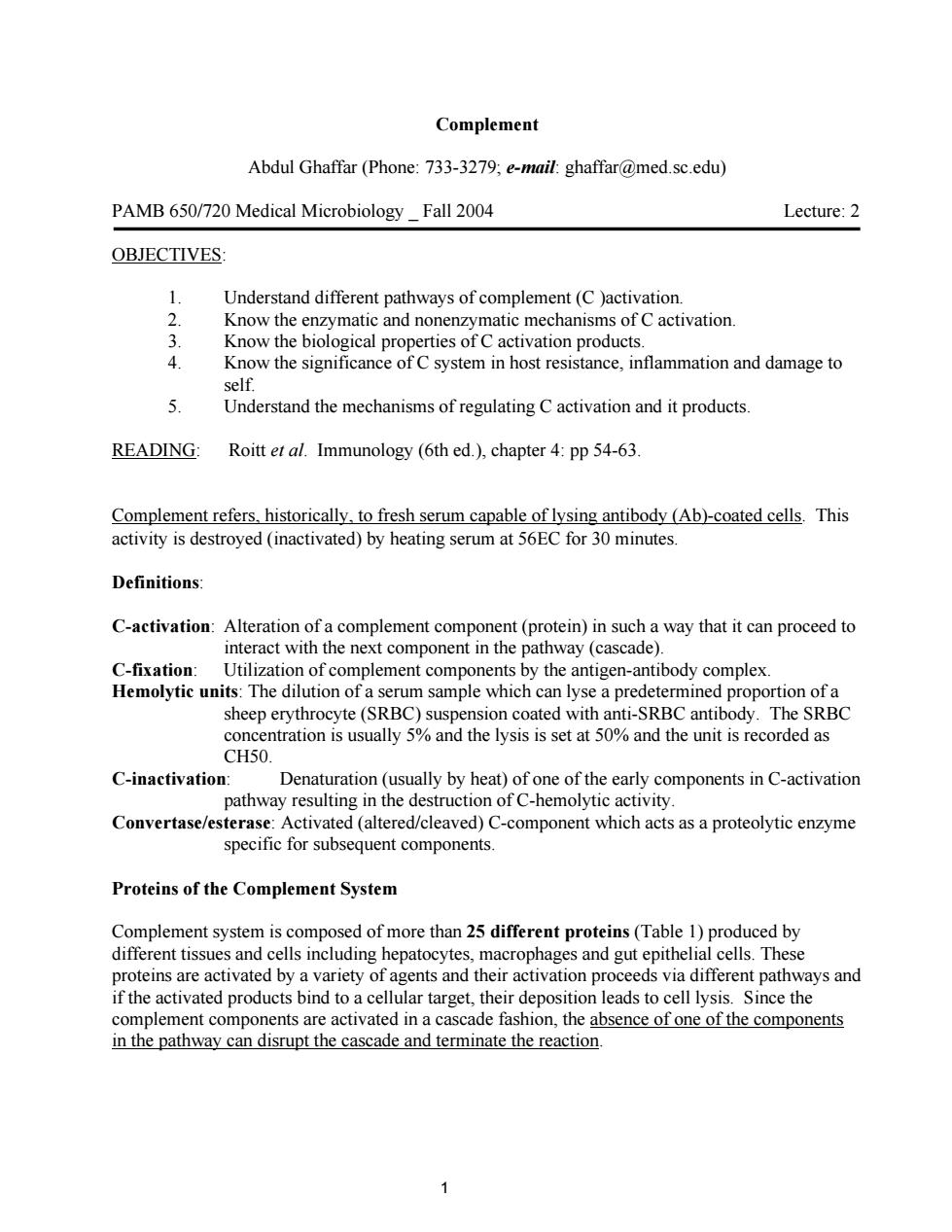正在加载图片...

Complement Abdul Ghaffar(Phone:733-3279;e-mail:ghaffar@med.sc.edu) PAMB650/720 Medical Microbiology_Fall 004 Lecture:2 OBJECTIVES Understand different pathways of complement(C )activation. Know the enzymatic and nonenzymatic mechanisms of C activation Know the biol gical properties of Cactivation products 4. Know the significance of C system in host resistance,inflammation and damage to self. 5. Understand the mechanisms of regulating C activation and it products. READING: Roitt etal.Immunology (6th ed.),chapter 4:pp 54-63. Complement refers,historically,to fresh serum capable of lysing antibody (Ab)-coated cells.This activity is destroyed (inactivated)by heating serum at 56EC for 30 minutes. Definitions: C-activation:Alteration of a complement component(protein)in such a way that it can proceed to interact with the next cor mponent in the pathway (cascade). C-fixation: on of complement t comp he ntigen-antibody complex Hemolytic units:The dilution of a serum sample which can lyse a predetermined proportion of a sheep erythrocyte(SRBC)suspension coated with anti-SRBC antibody.The SRBC concentration is usually 5%and the lysis is set at 50%and the unit is recorded as CH50. C-inactivation: Denaturation(usually by heat)of one of the early components in C-activation pathway resulting in the destruction of C-hemolytic activity. Convertase/esterase:Activated(altered/cleaved)C-component which acts as a proteolytic enzyme specific for subsequent components. Proteins of the Complement System Complement system is composed of more than 25 different proteins(Table 1)produced by different tissues and cells including hepatocytes,macrophages and gut epithelial cells.These proteins are activated by a variety of agents and their activation proceeds via different pathways and if the activated products bind to a cellular target,their deposition leads to cell lysis.Since the activated in a nion,the absence of one of the components in the pathway can disrupt the cascade and temminate the reaction. 1Complement Abdul Ghaffar (Phone: 733-3279; e-mail: ghaffar@med.sc.edu) PAMB 650/720 Medical Microbiology _ Fall 2004 Lecture: 2 OBJECTIVES: 1. Understand different pathways of complement (C )activation. 2. Know the enzymatic and nonenzymatic mechanisms of C activation. 3. Know the biological properties of C activation products. 4. Know the significance of C system in host resistance, inflammation and damage to self. 5. Understand the mechanisms of regulating C activation and it products. READING: Roitt et al. Immunology (6th ed.), chapter 4: pp 54-63. Complement refers, historically, to fresh serum capable of lysing antibody (Ab)-coated cells. This activity is destroyed (inactivated) by heating serum at 56ΕC for 30 minutes. Definitions: C-activation: Alteration of a complement component (protein) in such a way that it can proceed to interact with the next component in the pathway (cascade). C-fixation: Utilization of complement components by the antigen-antibody complex. Hemolytic units: The dilution of a serum sample which can lyse a predetermined proportion of a sheep erythrocyte (SRBC) suspension coated with anti-SRBC antibody. The SRBC concentration is usually 5% and the lysis is set at 50% and the unit is recorded as CH50. C-inactivation: Denaturation (usually by heat) of one of the early components in C-activation pathway resulting in the destruction of C-hemolytic activity. Convertase/esterase: Activated (altered/cleaved) C-component which acts as a proteolytic enzyme specific for subsequent components. Proteins of the Complement System Complement system is composed of more than 25 different proteins (Table 1) produced by different tissues and cells including hepatocytes, macrophages and gut epithelial cells. These proteins are activated by a variety of agents and their activation proceeds via different pathways and if the activated products bind to a cellular target, their deposition leads to cell lysis. Since the complement components are activated in a cascade fashion, the absence of one of the components in the pathway can disrupt the cascade and terminate the reaction. 1